| Vsevelod III, who had earlier had rebuilt the fire-damaged Dormition Cathedral in Vladimir, had this new church of St. Dmitri built in the palace courtyard. It was dedicated to St Dmitri of Salonika, his patron saint, for whom his son Dmitri, born the year the palace church was begun, was named. It also housed relics of the saint.
Scholars puzzle over the style because there is no record that builders from elsewhere were summoned to build the church, and because the style seems to be a mix of derivations. Brumfield quotes Meyer Schapiro who noted that Romanesque art often borrowed from widely diverse sources. The carved facades in particular are the subject of much discussion of provenance. Of the plan, Hamilton says, "this was a four-piered church with a single dome, and with entrance on each side on axis in the Armenian manner" (60). The church is unique in this area because of the extensive use of carved stone relief on the upper walls and the drum of the dome. Although much of the carving was reworked in restorations in the 18th and 19th centuries, scholars can distinguish 12th century sculpture from later replacements (I can't tell that!) although if original figures were moved or rearranged, that is generally unknown. |
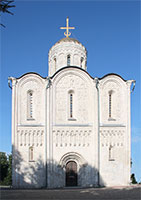 |
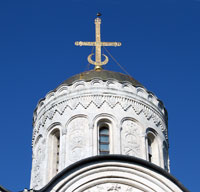 |
The west frontThere are triple panels on each facade with relief carvings and between the windows of the dome |
| |
|
Central zakomara (semi-circular gable) over entrance portalThe central panel on each facade has the figure of an enthroned King David with his right hand raised in blessing and the left holding a Psalter. Commenting on a somewhat earlier church in nearby Bogoliubovo built by an earlier prince (Prince Andrei Bogoliubskii), Brumfield underlines the importance of King David: "as God's anointed, the king of Judah, he represents the warrior-leader who defeated his enemies and united the various factions within his kingdom. . ." (50). "Surrounding David are creatures of the sky and earth, among them eagles, doves, peacocks, lions, panthers, pheasants, hares, as well as fantastic creatures such as griffins, centaurs, and the basilisk" (Brumfield 54). |
 |
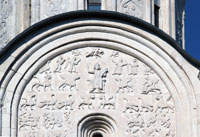 |
 |
| |
|
Lavish carvingSome carvings resemble western European sculpture; others are compared to Eastern models, like Scythian folk art, "especially evident in winged lions, griffin-headed birds, and other fantastic animals of a type which remained popular in peasant embroidery. . ." (Rice 34). Some interlace designs may owe to Scandinavian sources. And most of the designs are low relief, familiar in wood carving. |
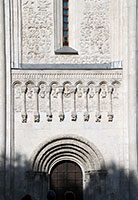 |
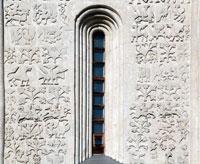 |
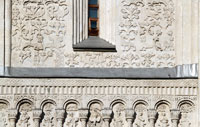 |
| |
|
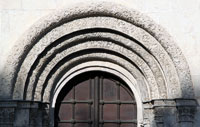 |
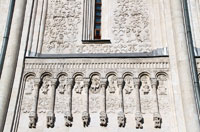 |
Plain window surrounds (above) but decorative carved archivolts in the recessed portal |
| |
|
The arcade friezeThe Holy Spirit is in the center flanked by Evangelists, seated as a way of indicating their regal position. |
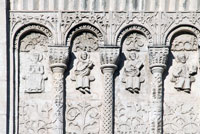 |
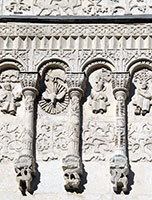 |
 |
| |
|
 |
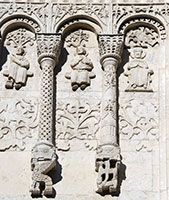 |
|


 Click here to return to index of art historical sites.
Click here to return to index of art historical sites.
 Click here to return to index of artists and architects.
Click here to return to index of artists and architects.
 Click here to return to chronological index.
Click here to return to chronological index.
 Click here to see the home page of Bluffton University.
Click here to see the home page of Bluffton University.

